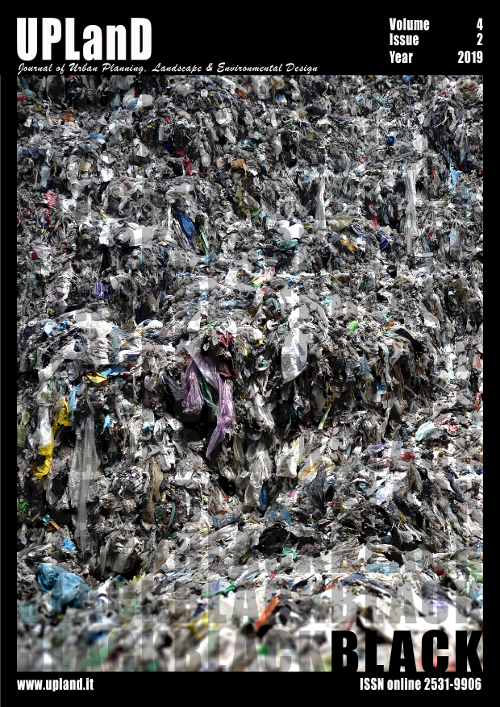Landscape requalification of landfills: an open issue between legal and technical aspects
Main Article Content
Abstract
The functional requalification of a modern landfill over the aftercare phase represents a landscape challenge since, in addition to technical and legal problems (also common to other waste management plants), long-term emissions must be taken into account. In fact, if for plants such as incinerators or composting after the operational phase an environmental recovery can be considered full, safe and healthy usable for the society in a relatively short period of time (1-5 years), for landfills the achievement of a sustainable and stable state of waste may require, a time much longer than that of the post-closure phase even for modern landfills (30 years). This state known as “final storage” refers to the quality reached by emissions and waste in chemical, biological and geological terms when all active control measures can be safely removed and it represents the necessary condition to guarantee the landfill requalification and its return back to the community with a new planned use as natural, recreational, didactic and social ones. Also, principles of landscape planning such as the specific legislation, the costs analysis and the territory analysis must be considered.
Downloads
Article Details

This work is licensed under a Creative Commons Attribution-NonCommercial-NoDerivatives 4.0 International License.
Authors who publish with this journal agree to the following terms:- Authors retain copyright and grant the journal right of first publication with the work simultaneously licensed under a Creative Commons Attribution License that allows others to share the work with an acknowledgement of the work's authorship and initial publication in this journal.
- Authors are able to enter into separate, additional contractual arrangements for the non-exclusive distribution of the journal's published version of the work (e.g., post it to an institutional repository or publish it in a book), with an acknowledgement of its initial publication in this journal.
- Authors are permitted and encouraged to post their work online (e.g., in institutional repositories or on their website) prior to and during the submission process, as it can lead to productive exchanges, as well as earlier and greater citation of published work (See The Effect of Open Access).
References
Artuso, A., & Cossu, E. (2017). Afteruse of Landfills: methodological approach, project requisites and relationship with the territory. In Proceedings Sardinia_2017. Sixteenth International Waste Management and Landfill Symposium. Padova, IT: CISA Publisher.
Belevi, H., & Baccini, P. (1989). Long-term behavior of municipal solid waste landfills. Waste Management and Research 7(1), 43–56. doi: 10.1016/0734-242X(89)90007-4
Cossu, R. (2016). Back to Earth Sites: From ‘‘nasty and unsightly” landfilling to final sink and geological repository. Waste Management 55, 1–2. doi: 10.1016/j.wasman.2016.07.028
Cossu, R., & Stegmann, R. (2018a). Waste management strategies and role of landfilling. In R. Cossu & R. Stegmann (Eds.), Solid Waste Landfilling Concepts, Processes, Technology. Amsterdam, NL: Elsevier.
Cossu, R., & Stegmann, R. (2018b). Landfill planning and design. In R. Cossu & R. Stegmann (Eds.), Solid Waste Landfilling Concepts, Processes, Technology. Amsterdam, NL: Elsevier.
Dazlero, S. (2016). Waste disposal and recycling sites perspectives and contemporary approaches. In Proceedings SUM2016, Third Symposium on Urban Mining and Circular Economy, 23 - 25 May 2016 Old Monastery of St. Augustine, Bergamo, Italy. Padova, IT: CISA Publisher.
Fabian, L., & Munarin, S. (Eds.). (2018). Re-Cycle Italy. Atlante. Siracusa, IT: Letteraventidue.
Garbo, F., Lavagnolo, M.C., Malagoli, M., Schiavon, M., & Cossu, R. (2017). Different leachate phytotreatment systems using sunflowers. Waste Management, 59, 267-275. doi:10.1016/j.wasman.2016.10.035
ISPRA (2016). Rapporto rifiuti Urbani - edizione 2016. Retrieved form:
http://www.isprambiente.gov.it/it/pubblicazioni/rapporti/rapporto-rifiuti-urbani-edizione-2016
Keeble, B. R. (1988). The Brundtland report:‘Our common future’. Medicine and War, 4(1), 17-25. doi: 10.1080/07488008808408783
Kjeldsen, P., Barlaz, M. A., Rooker, A. P., Baun, A., Ledin, A., & Christensen, T. H. (2002). Present and long-term composition of MSW landfill leachate: a review. Critical reviews in environmental science and technology, 32(4), 297-336. doi: 10.1080/10643380290813462
Lavagnolo, M.C., Malagoli, M., Garbo, F., Pivato, A., & Cossu, R. (2016). Lab-scale phytotreatment of old landfill leachate using different energy crops. Waste Management, 55, 265-275. doi: 10.1016/j.wasman.2016.06.016
Lavagnolo, M.C., & Pivato, A. (2008). Problematiche di post-gestione delle discariche per rifiuti solidi urbani. Recycling 61, 53–63.
Pivato, A., Garbo, F., Moretto, M., & Lavagnolo, M. C. (2018). Energy crops on landfills: functional, environmental, and costs analysis of different landfill configurations. Environmental Science and Pollution Research, 25(36), 35936-35948. doi: 10.1007/s11356-018-1452-1
Pivato, A. (2011). Landfill liner failure: an open question for landfill risk analysis. Journal of Environmental Protection, 2(3), 287-297. doi:10.4236/jep.2011.23032
Pivato, A., & Cossu, R. (2007). Emissioni di lungo periodo e strategie di gestione del post-esercizio di discariche. Rifiuti Solidi, 21(2), 76-84.
Pivato, A., Masi, S., De Caprio, D., & Tommasin, A. (2018). Sanitary landfill costs from design to aftercare: criteria for defining unit cost. Detritus 4, 140–156. doi:10.31025/2611-4135/2018.13748
Pivato, A., Vanin, S., Palmeri, L., Barausse, A., Mangione, G., Rasera, M., & Gianluca, M. (2013). Biopotentiality as an index of environmental compensation for composting plants. Waste management, 33(7), 1607-1615. doi:10.1016/j.wasman.2013.03.023
Raga, R., & Cossu, R. (2014). Landfill aeration in the framework of a reclamation project in Northern Italy. Waste management, 34(3), 683-691. doi:10.1016/j.wasman.2013.12.011
Raga, R., Cossu, R., Heerenklage, J., Pivato, A., & Ritzkowski, M. (2015). Landfill aeration for emission control before and during landfill mining. Waste management, 46, 420-429. doi:10.1016/j.wasman.2015.09.037
Savino, M., (2016). Prospettive di resilienza?. Sentieri Urbani, 20, 15-19.

